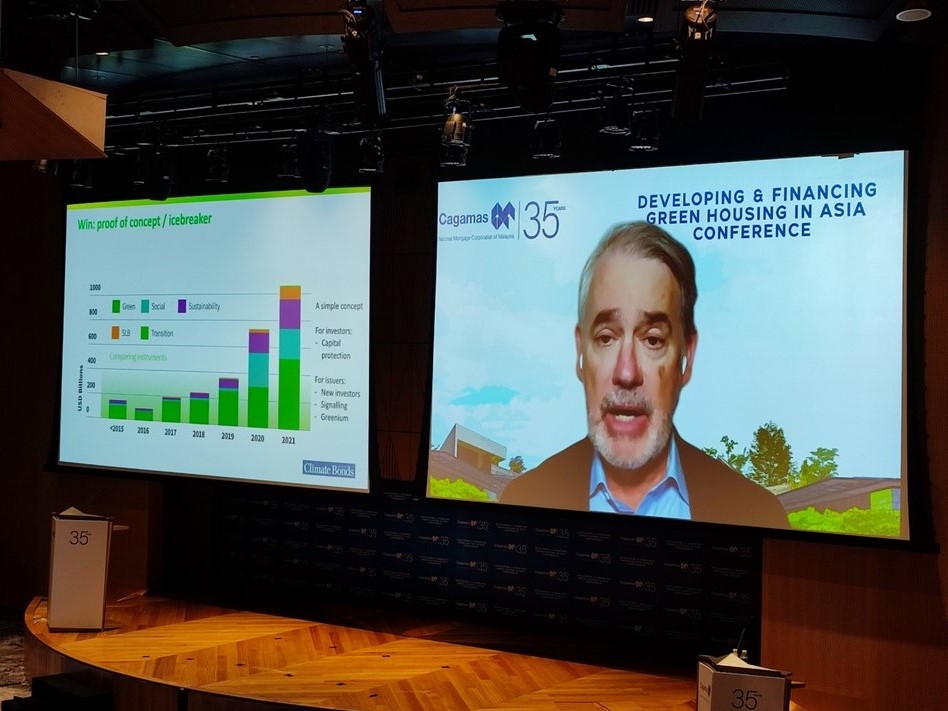How Green infrastructure can be supported through government financing and policy
23 SEPTEMBER 2022 – Malaysia is committed to its target of becoming a net zero-carbon by 2050 to meet Paris agreement goals, and efforts to accelerate the Green economy growth are at the core of the country’s socio-economic development. This was discussed at the Developing and Financing Green Housing in Asia Conference, held on 21 September 2022 at Khazanah Auditorium, Asia School of Business.

Sean Kidney presenting at Developing and Financing Green Housing in Asia Conference. Image courtesy of Cagamas
The one-day conference was organised by Cagamas Berhad, the National Mortgage Corporation of Malaysia, in collaboration with the ASEAN Catalytic Green Finance Facility and the ASEAN+3 Asian Bond Markets Initiative. Key figures in the public and private sector were invited to share their perspectives on Green housing, finance and investment, and shed a light on the industry’s prospects and ambitions.
Sean Kidney, Chief Executive Officer of Climate Bond Initiative posited that the property sector can lead the way in hastening the development of Green financing with government support and policies. “In labelling the buildings, the Malaysian Green Building Council (MGBC) is doing a good job in this area. The government and authorities need to support that and look for ways to insert the idea of labelling buildings into [other] transactions,” said Kidney.
Among the things that are under MGBC’s purview are realising energy savings, water conservation, a healthier indoor environment, better public connectivity, recycling of valuable resources and provision of greenery in developments. Assessment and labelling measures include the health of the buildings as well as resilience in climate change. “One thing is to have proper insulation as cities are going to have incidents of heat. Kuala Lumpur is not doing all that bad but it could do better,” Kidney remarked.
On the financing side, value capture could support the development and sustenance of Green infrastructure, such as allowing subways to be financed by building shopping and commercial centres and apartments above the stations. “MTR [Mass Transit Railway] in Hong Kong as we know is a 75 per cent owned government entity. It returns a dividend to the government because it makes profit from its subways.”
In regulatory measures, Green buildings could also be supported at the urban planning level. “It can be [through] allowing differential heights in planning, say, if you build a zero carbon building, you get an extra five floors. Or on the other side, [having] regulatory measures to stop the lending to inefficient buildings.”
Governments and authorities need to be very clear on the approach to green financing on what qualifies and find a way to assist the work of organisations such as MGBC in Malaysia.
Learnings from Thailand’s housing authority
Virtually attending from Thailand, Sukumaporn Jongpukdee, Assistant Governor of Thailand’s National Housing Authority (NHA) also shared key findings from the Green housing development in her country. In order to achieve Sustainable Development Goals (SDGs), the NHA has incorporated a Bio-Circular-Green (BCG) economic model.
Presentation by Sukumaporn Jongpukdee. Images from Developing and Financing Green Housing in Asia Conference
An example is the pilot project of Ban Kheha Sukpracha rental housing for low-income earners, and other NHA-operated townships like Din Daeng Smart City that are created with sustainable community development in mind. This entails providing community elements such as workplaces, child daycares, healthcare services, and even a career development centre. These elements all work to ensure citizens’ welfare within their living environment, reducing the need for carbon-intensive transportation to other areas and achieve the goal of environmentally friendly development.
Similar to Malaysia, some of the challenges encountered in the provision of Green affordable housing was financial pressure that prevents investment in eco-friendly solutions, technical limitations and inadequate promotion of Green materials or criteria. Among the solutions the NHA proposed was increasing research and development in developing affordable housing technology, and strengthening technical capacity and know-how for Green technologies as a whole, including for project construction management.
Read more stories about Green housing:
Mainstreaming Green throughout the housing value chain



